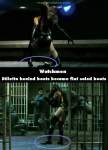
Continuity mistake: During the prison fight scene, Silk Spectre's stiletto boot heels are alternatively flat-soled from shot to shot, for the stunt woman's benefit.
Audio problem: During the battle in Adrian Veidt's lair he catches a bullet. He pulls the slug from his palm but as he drops the slug we hear the sound of a spent shell casing hitting the floor (empty brass) not the heavy lead bullet.
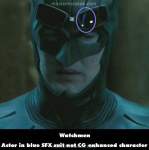
Revealing mistake: During the final confrontation in Veidt's lair, you see the actor Billy Crudup in his SFX suit reflected in Nite Owl's goggles, not the image of Dr. Manhattan.
Continuity mistake: In the scene where Silk Spectre II visits Nite Owl II at his home, the small mole on her cheek disappears only to reappear again when they leave to visit Hollis Mason (Nite Owl I). It doesn't appear to be a staple of Spectre's makeup in any way and is instead permanent, as it was present when she left Dr. Manhattan to visit Nite Owl (directly before) and on the way to visit Hollis (directly after) as well as through the rest of the film.
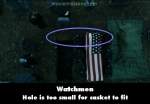
Other mistake: During the Comedian's funeral, in a shot from above showing both grave and the casket, the grave is actually shorter than the casket. (00:33:55)
Character mistake: While he is describing his origin, Dr. Manhattan mentions a circulatory system appearing at a military base. However, what is actually shown is a nervous system, as it depicts a brain and spinal cord.
Revealing mistake: In the scene in the Vietnamese bar, after the Comedian shoots his ex-lover and she falls to the floor, the camera shows a quick, panned-out shot of Dr. Manhattan and the woman on the floor. The bottom of her shirt is flipped up, revealing straps of the false pregnancy stomach she was wearing.
Deliberate mistake: Though the film takes place over the course of several weeks, at night there is always a full moon.
Revealing mistake: When Dr. Manhattan is interviewed on TV, his ex-girlfriend Janey makes a surprise appearance in the television studio and launches into emotional accusations. In one shot, we see both Janey shouting in the background and a live television monitor close-up of her face in the foreground. However, the TV monitor close-up shows Janey making completely different head movements than she is making in the background.
Continuity mistake: In "The Ultimate Cut" version of the film (and perhaps the original), Laurie and Dan have a discussion in a restaurant about the attack on Ozymandias. Outside, across the street we see people milling about. As the camera cuts between shots of both characters at the table, then close ups of Spectre, then of Night Owl, and back again, the positions of these people vary randomly, including a seated girl that appears instantly out of nowhere, then a man in a brown jacket walks over to join her, but instantly is seated next to her, then he's seen approaching and sitting down with her. (Timecode is for The Ultimate Cut). (01:41:10)
Revealing mistake: In the scene in which Dr. Manhattan is dressing himself, as he turns his head at the end, his CGI neck can be seen going through the collar of his shirt.
Factual error: In the scenes on Mars, two spherical moons can be seen in the background. However, in reality, the moons of Mars (Phobos & Deimos) are not spherical. Also they are so small, that they would only appear as moving dots in the night sky, not spheres like Earth's moon.
Revealing mistake: When Dr. Mahattan and Silk Spectre are on Mars and they are climbing upward in his gyrating clockwork structure, a shot from well above, behind and to the right of them contains some terrible CGI work of Silk Spectre walking in a completely unnatural, very mechanical way.
Continuity mistake: When Rorschach throws the basket of grease on the convict in prison, the convict covers his face with his hands in pain. In the following shot, his hands are father from his face than they were before. (01:31:45)
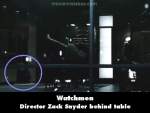
Visible crew/equipment: At the beginning of the movie when the Comedian is fighting with the mysterious masked man in his apartment and the first one is launched towards the table, the director Zack Snyder is hidden behind the kitchen counter and kneeling (this mistake is revealed by Snyder himself in the DVD extras).
Character mistake: Typo in lower part of newspaper in line below "Chicago Seven Acquitted" headline. It reads "13 Injured As Thousands Protest Vedict". I assume they meant "Verdict". (00:14:45)

Revealing mistake: When Veidt and his cat Bubastis is walking over the bodies of the scientists after he poisons them, you only see Veidt's reflection and not Bubastis' in the energy panels on the walls as he walks towards and up the stairs.
Continuity mistake: When Kovacs is being interviewed before being given the Rorshach test, a pill bottle is shown on the table in front of him. The front label of the bottle faces Kovacs when first seen, but a moment later, with nobody touching it, the bottle has turned 90-degrees so that the label faces left of Kovacs, toward the camera. (Timecode is for The Ultimate Cut). (01:50:50)
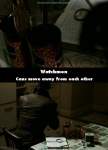
Continuity mistake: When Dan returns home after talking to Mason, he finds Rorschach in his kitchen eating beans from a can. After he has finished eating, he throws the second can on the table where it lands next to another can. When he gets up, the two cans have moved significantly apart. (00:20:15)
Plot hole: Although this film is a virtual jigsaw puzzle of flashbacks, the dynamic between Dan, Laurie and Rorschach pretty much defines the movie's continuity in the present. However, when Rorschach is framed for murder and arrested, he goes directly to a maximum-security prison, apparently without trial, conviction or sentencing (all of which would require months of due-process, at least). Even if this lapse of time is some sort of artistic device to rapidly advance Rorschach's story, there is no corresponding lapse of months in the relationship between Dan and Laurie, which runs parallel with Rorschach's story. Either there is no due process for Rorschach in this story, or there is a glaring plot hole.
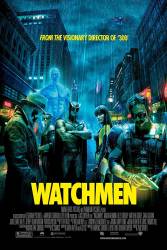





Suggested correction: Rorschach was a famous and dangerous outlaw. We are talking about an alternate 80's here with Nixon as president and a nation-wide ban on masks (the Keene Act). Rorschach probably faced the death penalty for his long list of crimes, besides the murder he was finally captured for (not to mention to handful of cops he seriously injured whilst trying to evade capture). I don't think it's strange that his trial was quick or not fully by the book. They made sure he was locked away fast and quietly. The justice system probably works a lot faster in a world of masked vigilantes.
lionhead
Yes, Rorschach was a vigilante; but, before masked superheroes were outlawed, Rorschach was also responsible for sending dozens (if not scores) of far worse criminals to prison, thus benefitting society. This much is stated in the film. His contributions to justice would certainly carry weight, and testimony in his favor would have to be considered in any legal proceedings against him. Also, after his capture, authorities were still trying to assess his mental state, which implies that some sort of due-process was still in place. Rorschach should have received a months-long trial, at the very least.
Charles Austin Miller
To be fair, the original, Hugo Award-winning "Watchmen" graphic novel makes the same continuity leap when it comes to Rorschach's fate. Rorschach keeps a secret diary that dates everything, but it egregiously skips over his trial and sentencing, even though the relationship between Dan and Laurie remains consistent. So, we can say that the movie is faithful to the novel, but the novel itself is flawed with a gaping plot hole.
Charles Austin Miller
The cops of that city don't care about his past deeds, which includes dropping the body of a criminal in front of the police station with the message "Never." They don't like him. Not even his colleagues liked him. That was a long time ago too, he's been the sole masked vigilante for a long time and I bet the cops just started disliking him more and more for his antics. Thus, a quick trial.
lionhead